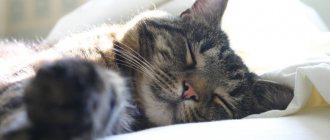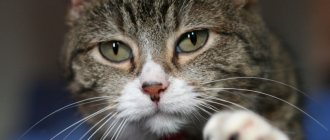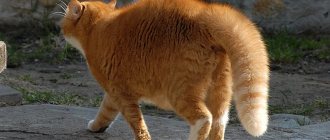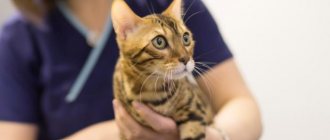If a cat falls from a height and lands unsuccessfully, then injury and bruise cannot be avoided. Of course, the health of the animal is not threatened by jumping from a cabinet, table, bed or tree. But if a cat fell out of a window from the fifth floor or even from the third, there is a high probability of fractures, concussion, and damage to internal organs. Therefore, if a cat accidentally falls from a great height and has characteristic signs of damage, it is necessary to urgently take the pet to the veterinary clinic.
How dangerous is falling from a height for a cat?
The degree of damage a cat receives when falling from a window/balcony depends on several factors:
- the weight of the animal - the larger it is, the higher the risk of injury;
- the presence of obstacles on the way (branches, clotheslines) - this increases the likelihood of an unsuccessful landing;
- surface hardness - the chances of a soft landing increase if there is a lawn, flowerbed or snowdrift under the windows of the house;
- height. Oddly enough, “flights” from the 3rd–5th floor are more dangerous than from the 6th–8th floor, because in a short time the cat may not have time to group itself in such a way as to land on its paws. Falls from the height of a 9-story building often end even more tragically. In “flight” the pet will pick up speed, and even its innate plasticity will not soften the landing.
The animal world has its lucky ones. For example, Andy the cat, listed in the Guinness Book of Records, survived after falling from the 16th floor.
If a cat slips on the ebb of a plastic window, it will not be able to cling to the smooth surface and will inevitably fall.
If an animal falls from a window, it risks receiving the following injuries:
- traumatic brain injury (concussion, hemorrhage, cerebral edema);
- fracture of the jaw, teeth;
- bruise of internal organs and bleeding as a result of their ruptures;
- pneumo- and hemothorax (accumulation of air and blood in the pleural cavity);
- diaphragmatic hernia, i.e. displacement of abdominal organs into the chest;
- fractures of the spine, pelvis, ribs;
- dislocations and fractures of limbs;
- painful shock as a result of numerous injuries, leading to failures of the vital systems of the body - cardiovascular, respiratory, nervous.
Video: Why cats always land on their feet
Consequences
If a cat falls from the third floor or lower, then in most cases there are no serious consequences. The animal is in shock for a while and then lives a normal life.
If you jump from the sixth, seventh or higher floors, the risk of serious damage increases significantly. The consequences of a cat falling from a height are immediate and secondary.
The first group includes arrest of the respiratory process and heart, serious blood loss, and shock.
Secondary consequences arise after some time. These include inflammatory processes in internal organs, impaired functioning of the kidneys and liver, infections entering the wounded surface, and blood poisoning.
With correct and timely assistance, negative consequences rarely occur.
Important! It is necessary to quickly deliver the pet to the hospital to reduce the risk of developing malfunctions in the functioning of organs and systems
What to do if a cat falls from a height
First aid to a cat that has fallen from a window must be provided within 1–2 hours, otherwise the consequences may be disastrous:
- If the animal does not move, carefully, without changing the position of the body, place a thick sheet of cardboard, plywood or board under it and fix the head.
- Immediately transport the cat to a veterinarian or bring it home and keep it quiet until the doctor arrives.
- If your pet is unconscious, perform artificial respiration:
- pull out your tongue and close your nose;
- exhale deeply into your mouth through a piece of gauze (20 times per minute).
- If your cat is vomiting, lift its head and turn it to the side to prevent it from choking.
- If there are open wounds, apply a tourniquet (for no more than an hour) and a bandage soaked in a solution of furatsilin or chlorhexidine. If blood has completely soaked the material, add fresh blood on top.
- If you suspect internal bleeding, apply a cold compress to your cat's head and abdomen.
Absolutely forbidden:
- picking up and shaking an injured animal - this can cause additional damage;
- independently reduce dislocations;
- apply splints if you suspect a fracture of the spine or pelvis;
- force feed and water your pet;
- give him medications without consulting a doctor.
Video: first aid for a cat that has fallen from a height
Absolutely forbidden
There are a number of actions that can greatly harm a cat after a fall and negate all future efforts of doctors to save the cat.
- Apply splints and bandages for spinal injuries. This can lead to dangerous displacement of the bones, leading to irreversible consequences.
- Try to bring the cat to consciousness by shaking and shaking your pet, kissing her and hugging her to you.
- You should not forcefully try to feed or water your furry friend.
If outwardly there are no wounds, injuries, or injuries, then it is worth closely observing your pet for several days. If her behavior has not changed, she has not become lethargic, apathetic or aggressive, she still eats as well as before the fall, and copes with her needs normally, then there is no particular reason for concern. Except that the owners need to think about how to prevent the danger of falling for their pet.
There must certainly be special nets on the windows so that the kitty, carried away by playing with a butterfly or other insect, does not fall down in the excitement of the chase.
If changes are observed in the behavior, habits, or mood of the animal, consultation with a veterinarian is simply necessary. You may need to do an X-ray and ultrasound of the cat so as not to miss serious injuries and complications after them.
What are the symptoms of serious injury after a fall?
A visual inspection will tell you what injuries the cat received when it fell:
- if she lies motionless, most likely she has a spinal fracture;
- failure of the hind legs indicates damage to the pelvic bones;
- curvature of the limbs and lameness will indicate dislocations or fractures;
- vomiting and disorientation may suggest a concussion;
- heavy breathing will reveal a lung bruise;
- drooling and an open mouth are signs of a jaw fracture;
- an enlarged, painful abdomen combined with bleeding from the nose, mouth or anus indicates serious injury to internal organs;
- shallow breathing, pale mucous membranes, weak pulse suggest traumatic shock;
- blood in the urine will indicate a kidney injury.
If no visible damage is found, do not rush to relax. Alarming symptoms may appear later. Among them:
- drowsiness;
- aggression;
- decreased appetite;
- spitting out food;
- increased salivation;
- breathing problems due to diaphragmatic hernia;
- unsteady gait;
- reluctance to step on paws;
- forced poses;
- lack of urination (more than a day) and defecation (more than two days).
Once I saw a neighbor's cat fall from a 5th floor window. She landed, was in a stupor for several seconds, and then flew away in an unknown direction. This behavior does not at all mean that the animal remained safe and sound. The release of adrenaline into the blood from the resulting stress could temporarily dull the pain, and serious consequences would appear a little later. Unfortunately, nothing is known about the further fate of this cat.
If a cat falls, it can suffer internal injuries that are invisible to the eye, so in any case it is important to show it to a qualified veterinarian.
The most common injuries in cats
As a result of its natural mobility, cats receive various wounds, abrasions, bruises and scratches on the body. In addition, falls from a height often result in dislocations, cracks and fractures of the limbs.
In most clinical cases, the injuries are serious, threatening not only the normal functioning and mobility of the animal, but its future life. Domestic cats often suffer from wounds, sprains, dislocations, tendon ruptures and fractures received during fights with relatives or during car collisions.
The most common injuries in cats are:
- Abrasions and scratches. Cats receive such injuries from dogs or their fellow tribesmen. This also includes eye injuries in cats. During a fight, cats often strike with a paw with claws in the muzzle area and directly in the eye.
- Bruises. Damage characterized by several degrees (first, second, third and fourth). The mildest degree of bruises in a cat is characterized by slight damage to the upper layers of the cat and fatty tissue. In the second degree of bruises, delamination and rupture of muscle fibers occurs, the formation of hemorrhages and lymphatic extrovasation. Swelling and increased local temperature in the area of damage are possible. Against the background of pain, the cat’s respiratory process is disrupted and the pulse quickens. With bruises of the third and fourth degree, the damage is characterized by severe disorders of the nervous system, states of shock, necrosis of tissue structures, crushing of tissues and fragmentation of bones. Bruises often include tail injuries in cats. The danger of such damage lies in the fact that when a secondary infection (pathogenic bacterial or fungal microorganisms) is attached. Serious and dangerous purulent necrotic processes begin to develop, including sepsis.
- Bone fractures and cracks. Occurs mainly in cats living in urban environments. Fractures occur from falls from great heights, impacts from slipping from a roof, or muscle strain. There are a number of factors that contribute to fractures - rickets and osteodystrophy. When bone structures are fractured, muscle fibers, blood vessels and nerve endings are ruptured. Open fractures are also characterized by damage to skin structures and other tissues. A fracture in an animal is characterized by severe pain and impairment of the functional characteristics of the limbs. Severe swelling and swelling occurs. An accurate diagnosis is established exclusively with the help of radiographic examination.
- Wounds. Mechanical damage to tissue structures, characterized by a violation of the integrity of the skin and mucous membranes, is called a wound. This includes injuries to the ear, eyes, wounds on the sides or paws. Depending on what caused the damage to the integrity and location of the wound, there are cut wounds, bruised, crushed, bitten, stab and poisoned wounds. When toxic substances (poisons) penetrate into an open wound, mixed compounds develop.
- Traumatic brain injury. Brain damage in cats is caused by head contusions. With concussions, brain disorders occur in the brain stem and hypothalamic-pituitary system. Brain contusions are characterized by disturbances in the functioning of the cerebral hemispheres, the subcortical part and the cerebral cortex itself. Against the background of the pathological process, nerve impulses in vital centers of the brain are disrupted, and blood flow is disrupted. Against this background, necrotic processes and strokes are possible. After a concussion or bruise, an animal tries to get up, the pupils are dilated, the pulse accelerates, and wheezing occurs when breathing. There is hyperemia of the mucous membranes. Mild bruises of the brain are characterized by the development of paralysis, retinal detachment or even dislocation of the lens. Trigeminal nerve atrophy may develop.
- Spinal injuries. Spinal injuries in cats are characterized by weakened conduction along the nerve pathways from the brain to the spinal cord. Violation in the cervical region provokes paralysis of the hind and forelimbs and some internal organs. At the same time, the brain continues to maintain the functionality of the respiratory system. Mild contusions of the spinal cord are accompanied by minor paresis, and in severe cases, ruptures of the spinal roots and hemorrhages in the brain are possible.
What diagnostic methods are needed in a clinical setting?
At the veterinary clinic, the doctor will examine the animal and carry out diagnostic measures:
- clinical and biochemical blood tests;
- X-ray of the chest, which will exclude rib fractures, lung contusion, pneumo- and hemothorax;
- photographs of the skull, spine, pelvic bones, limbs if fractures are suspected;
- Ultrasound is indispensable in assessing the condition of internal organs (liver, spleen, kidneys, bladder).
Based on the results of the studies, the doctor will decide on the need for emergency surgery and will put on a drip - this will relieve stress, intoxication, pain, and compensate for blood loss. Surgical treatment of fractures is carried out after stabilization of the condition - on days 3-4.
What happens when you hit your head?
When an animal experiences a concussion, the functioning of the central nervous system and musculoskeletal system is disrupted for some time. Most often, cats suffer from mild concussions.
As you know, a strong concussion in a cat is the result of damage due to an impact. If proper treatment of a brain injury is not started in time, this is fraught with complications that can develop into chronic diseases that can worsen the pet’s health and limit its physical activity.
Every cat owner should be clearly aware that even a minor injury to the head can result in a concussion. Moreover, the more minor the damage, the more difficult it is to determine disorders in brain activity at home.
The cat may behave absolutely adequately, not suffer from a lack of appetite, and also not show signs of impaired motor functions. However, after some time, symptoms such as seizures, heart problems, and behavioral disorders may suddenly appear. This indicates a hidden brain injury.
Therefore, there is no need to wait for any symptoms of a concussion to appear after the impact - you need to take your pet to the veterinarian. Moreover, for emergencies there is a 24-hour veterinary clinic. It is better for this to be a false alarm than for the appearance of chronic diseases as a result of delayed treatment or lack of treatment at all.
Cautious Actions
It should be remembered that after being injured, a cat is in a state of shock and may react hostilely to attempts to provide help. Therefore, you need to act as carefully as possible so as not to worsen the condition of your mustachioed pet.
If the cat is unconscious, it must be transported by first laying it on its side and straightening its body. In this case, it is strictly not recommended to put the pet in a carrier or transport it while holding the animal in your arms. For transportation, a flat surface must be provided. If you notice a concussion in a cat, what should you do in this situation? A veterinarian can tell you about this.











